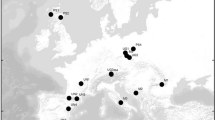Abstract
The Populus genus has evolved as the model organism for forest tree genomics, which has been further emphasised with the sequencing of the Populus trichocarpa genome. Populus species are widely spread over the Northern Hemisphere and provide a great source of genetic diversity, which can be used for mapping of quantitative trait loci, positional cloning, association mapping and studies in environmental adaptation. Collections of expressed sequence tags (ESTs) are rich sources in studies of genetic diversity. Here, we report on an in-depth analysis of 70,000 ESTs from two Populus species, Populus tremula and Populus trichocarpa. We present data on the level of conservation in transcript sequences and supply a collection of potential single nucleotide polymorphisms.


Similar content being viewed by others
References
Andersson A, Keskitalo J, Sjodin A, Bhalerao R, Sterky F et al (2004) A transcriptional timetable of autumn senescence. Genome Biol 5(4):R24
Bakker F, Culham A, Gomez-Martinez R, Carvalho J, Compton J et al (2000) Patterns of nucleotide substitution in angiosperm cpDNA trnL (UAA)–trnF (GAA) regions. Mol Biol Evol 17(8):1146–1155
Bhalerao R, Keskitalo J, Sterky F, Erlandsson R, Bjorkbacka H et al (2003) Gene expression in autumn leaves. Plant Physiol 131(2):430–442
Bonaldo MF, Lennon G, Soares MB (1996) Normalization and subtraction: two approaches to facilitate gene discovery. Genome Res 6(9):791–806
Bradshaw HDJ, Ceulemans R, Davis J, Stettler R (2001) Emerging model systems in plant biology: poplar (Populus) as a model forest tree. J Plant Growth Regul 19:306–313
Brunner AM, Busov VB, Strauss SH (2004) Poplar genome sequence: functional genomics in an ecologically dominant plant species. Trends Plant Sci 9(1):49–56
Buckler ES IV, Thornsberry JM (2002) Plant molecular diversity and applications to genomics. Curr Opin Plant Biol 5(2):107–111
Clegg MT, Cummings MP, Durbin ML (1997) The evolution of plant nuclear. Proc Natl Acad Sci U S A 94(15):7791–7798
Hamzeh M, Dayanandan S (2004) Phylogeny of Populus (Salicaceae) based on nucleotide sequences of chloroplast TRNT–TRNF region and nuclear rDNA. Am J Bot 91(9):1398–1408
Hellman I, Zöllner S, Enard W, Ebersberger I, Nickel B et al (2003) Selection on human genes as revealed by comparisons to chimpanzee cDNA. Genome Res 13:831–837
Hertzberg M, Aspeborg H, Schrader J, Andersson A, Erlandsson R et al (2001) A transcriptional roadmap to wood formation. Proc Natl Acad Sci U S A 98(25):14732–14737
Jones P (1999) The DNA methylation paradox. Trends Genet 15(1):34–37
Kent WJ (2002) BLAT—the BLAST-like alignment tool. Genome Res 12(4):656–664
Pesole G, Mignone F, Gissi C, Grillo G, Licciulli F et al (2001) Structural and functional features of eukaryotic mRNA untranslated regions. Gene 276(1–2):73–81
Rafalski A (2002) Applications of single nucleotide polymorphisms in crop genetics. Curr Opin Plant Biol 5(2):94–100
Rudd S (2003) Expressed sequence tags: alternative or complement to whole genome sequences? Trends Plant Sci 8(7):321–329
Schmid KJ, Sorensen TR, Stracke R, Torjek O, Altmann T et al (2003) Large-scale identification and analysis of genome-wide single-nucleotide polymorphisms for mapping in Arabidopsis thaliana. Genome Res 13(6A):1250–1257
Sterky F, Bhalerao R, Unneberg P, Segerman B, Nilsson P et al (2004) A Populus EST resource for plant functional genomics. Proc Natl Acad Sci U S A 101(38):13951–13956
Sterky F, Regan S, Karlsson J, Hertzberg M, Rohde A et al (1998) Gene discovery in the wood-forming tissues of poplar: analysis of 5,692 expressed sequence tags. Proc Natl Acad Sci U S A 95(22):13330–13335
Unneberg P, Strömberg M, Sterky F (2005) SNP discovery using advanced algorithms and neural networks. Bioinformatics 21(10):2528–2530
Wikström N, Savolainen V, Chase MW (2001) Evolution of the angiosperms: calibrating the family tree. Proc R Soc Lond B Biol Sci 268(1482):2211–2220
Yin TM, DiFazio SP, Gunter LE, Riemenschneider D, Tuskan GA (2004) Large-scale heterospecific segregation distortion in Populus revealed by a dense genetic map. Theor Appl Genet 109(3):451–463
Zhang J, Rosenberg HF, Nei M (1998) Positive Darwinian selection after gene duplication in primate ribonuclease genes. Proc Natl Acad Sci U S A 95:3708–3713
Acknowledgements
We thank Bo Segerman for data from PopulusDB. We are also grateful to Jacob Odeberg and Pär Ingvarsson for valuable comments on the text. This work was conducted under grants from The Knut and Alice Wallenberg Foundation.
Author information
Authors and Affiliations
Corresponding author
Rights and permissions
About this article
Cite this article
Unneberg, P., Strömberg, M., Lundeberg, J. et al. Analysis of 70,000 EST sequences to study divergence between two closely related Populus species. Tree Genetics & Genomes 1, 109–115 (2005). https://doi.org/10.1007/s11295-005-0014-0
Received:
Revised:
Accepted:
Published:
Issue Date:
DOI: https://doi.org/10.1007/s11295-005-0014-0




